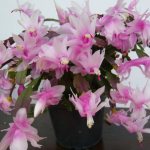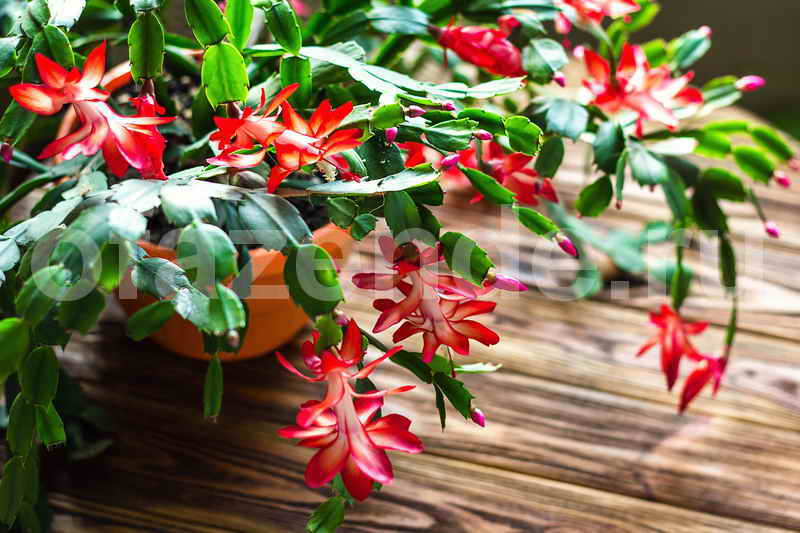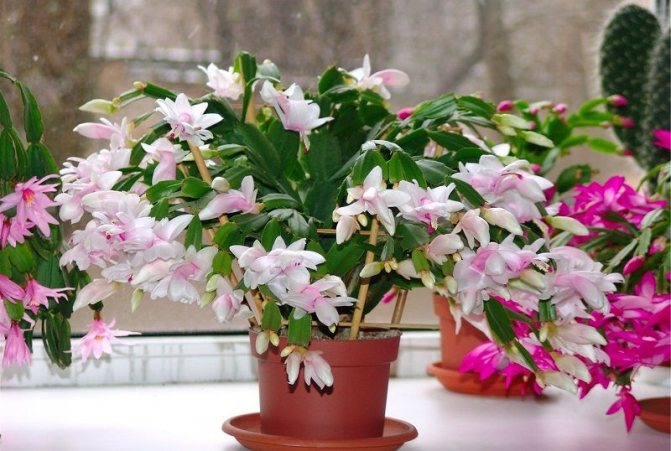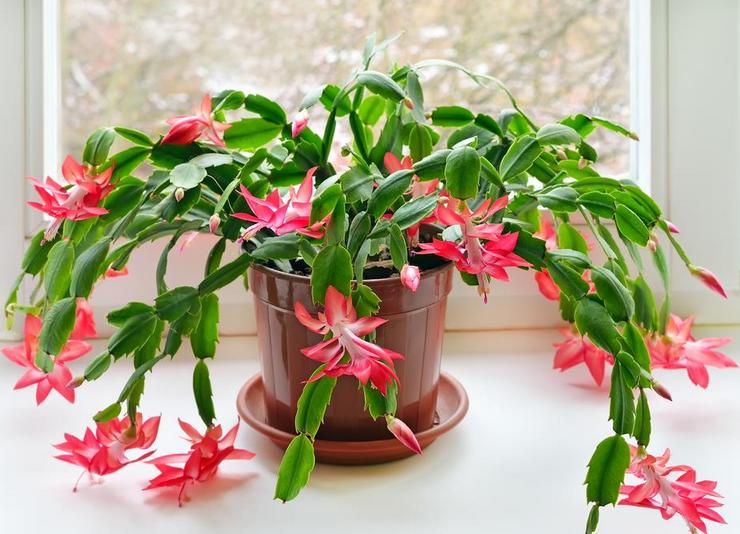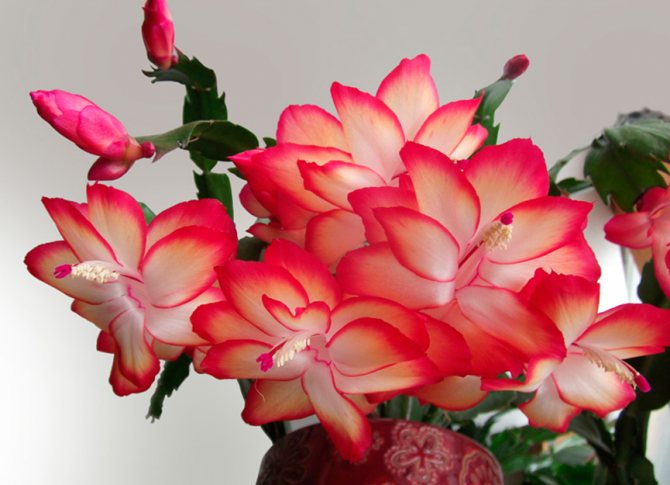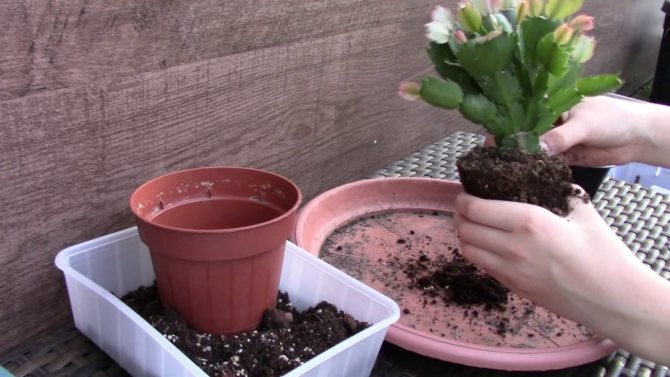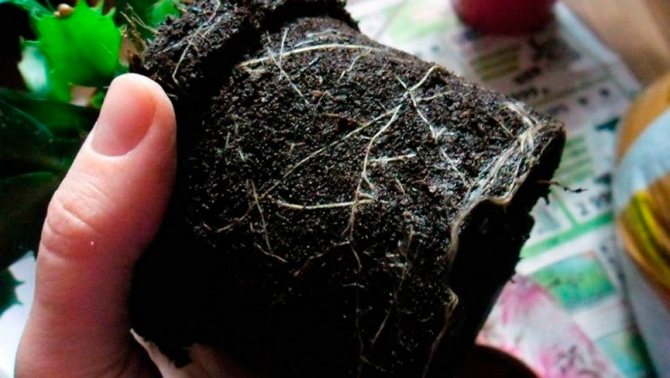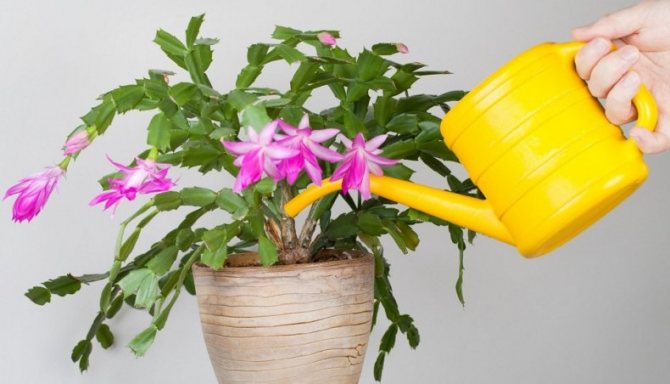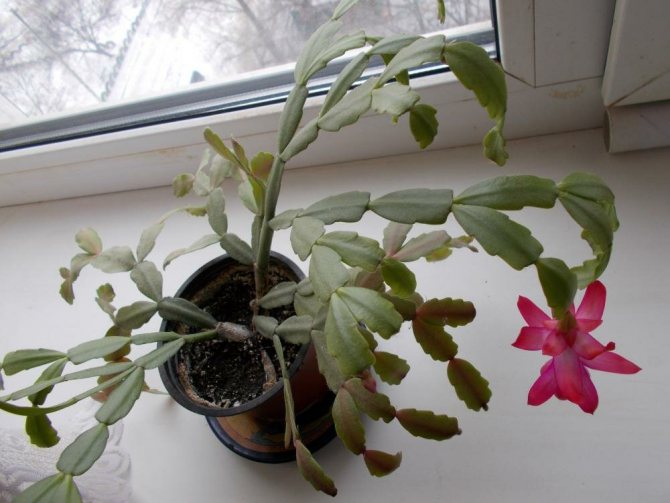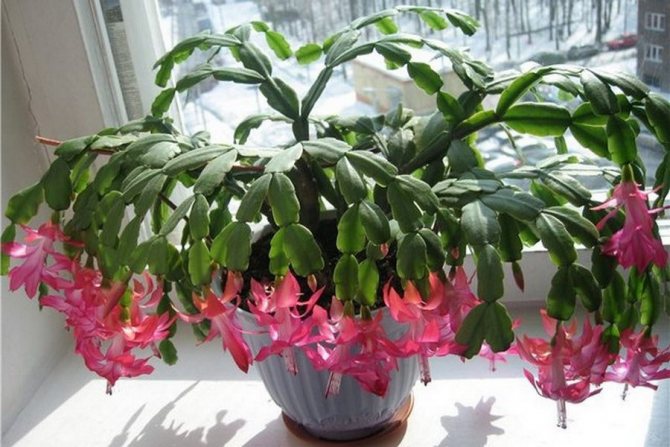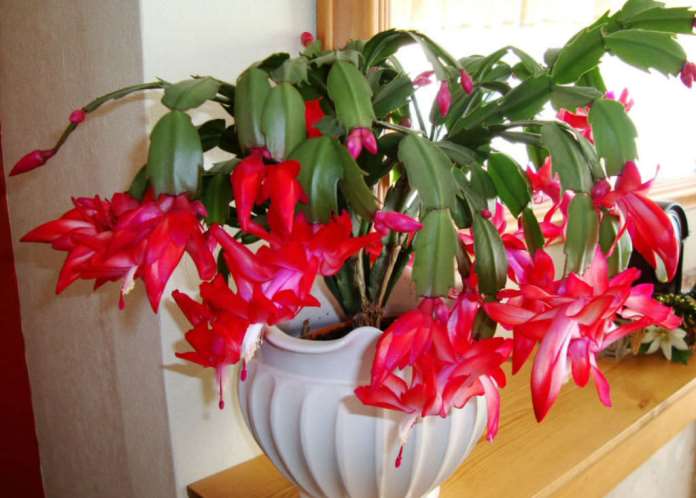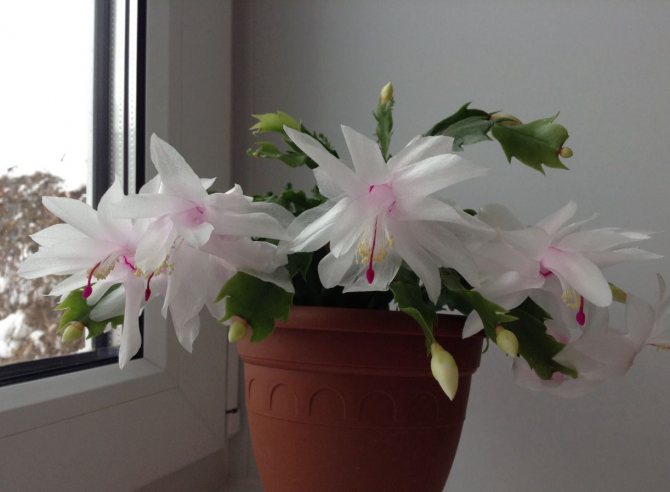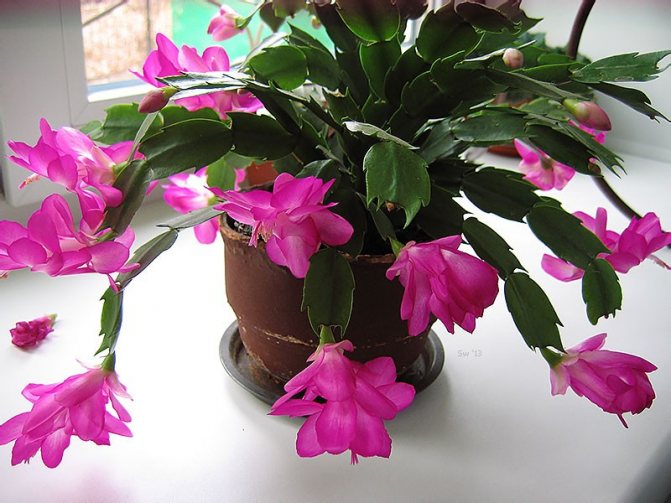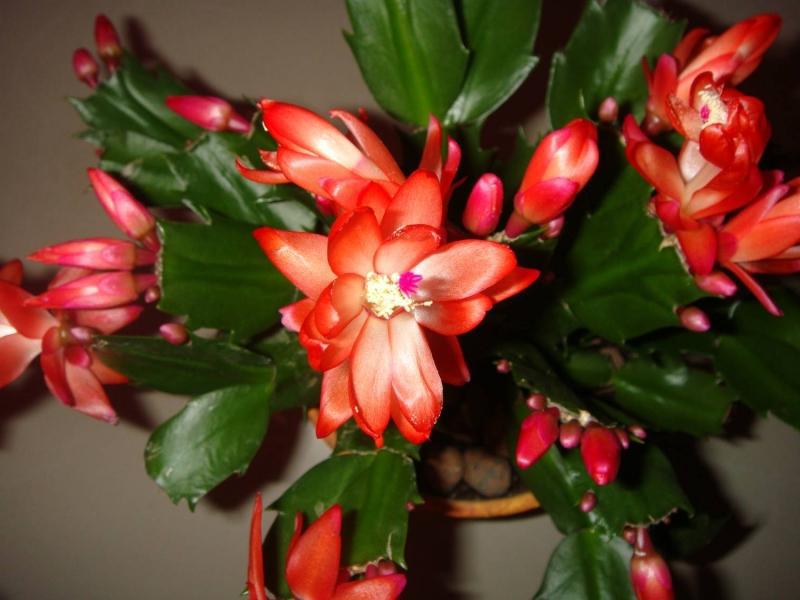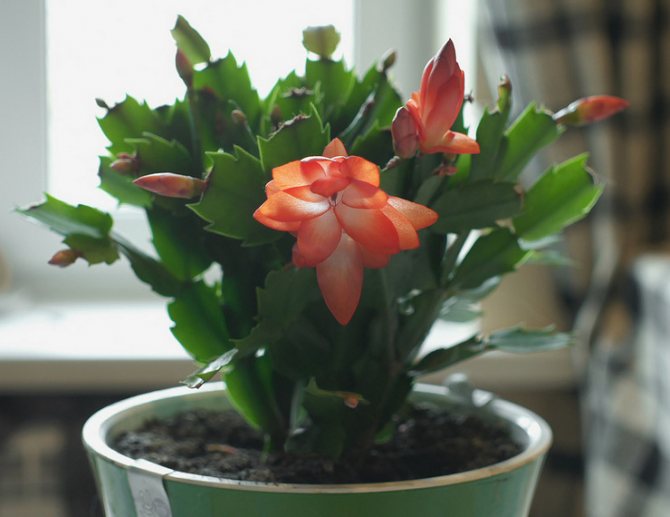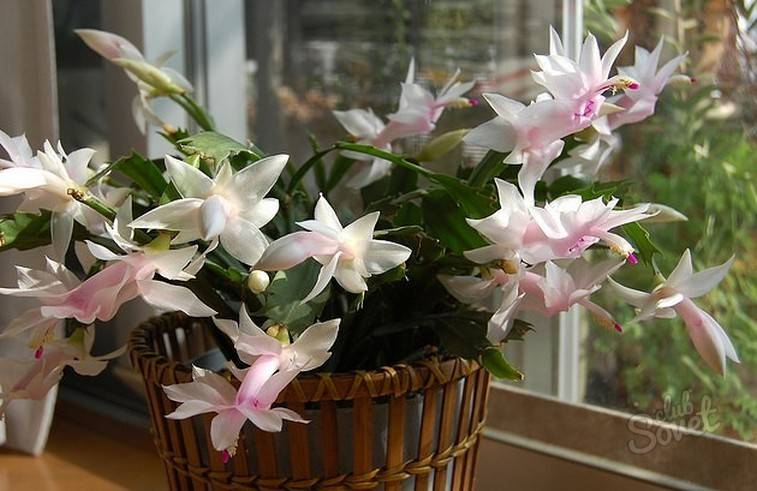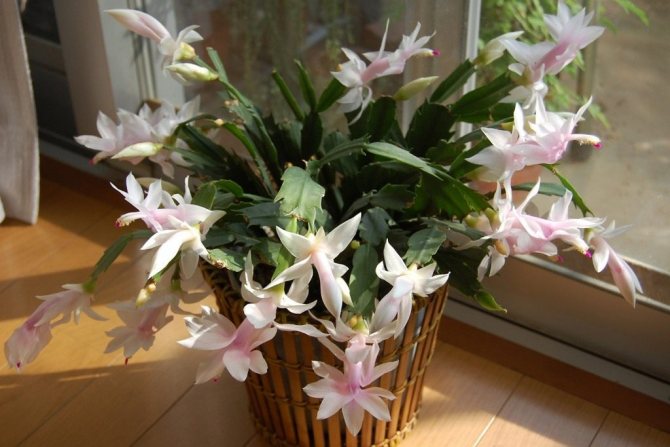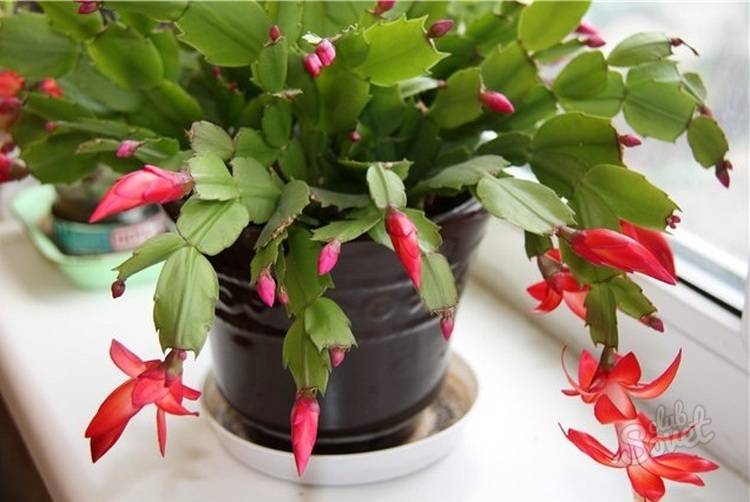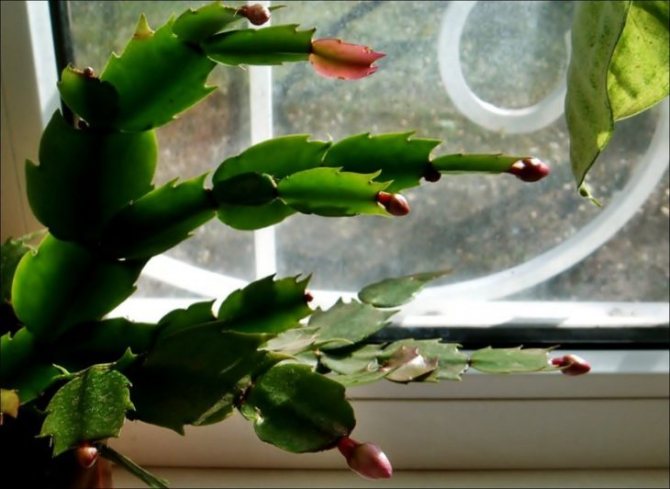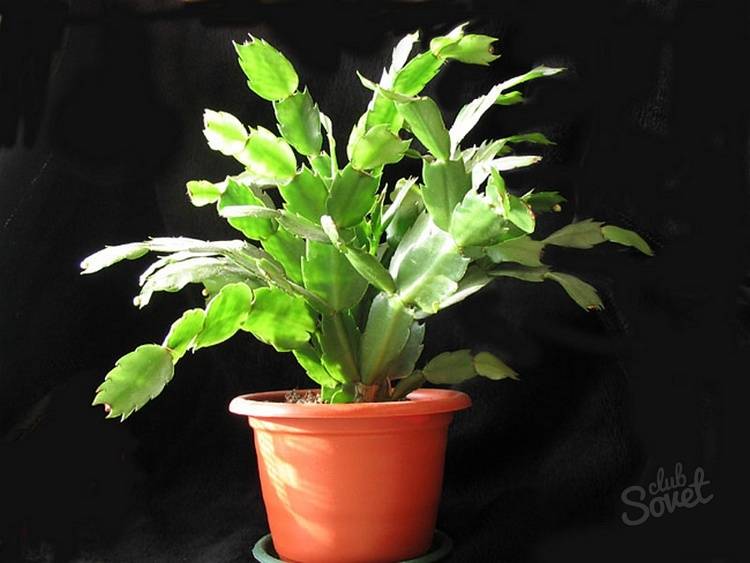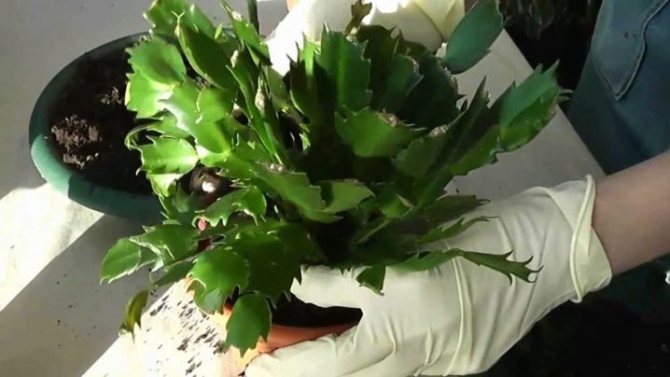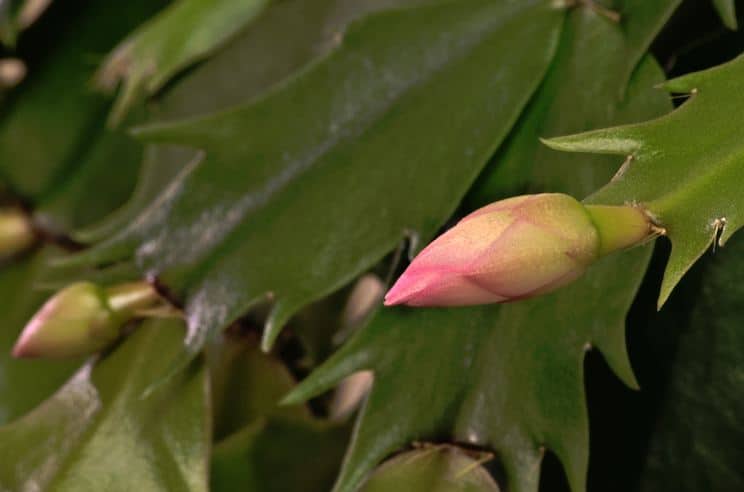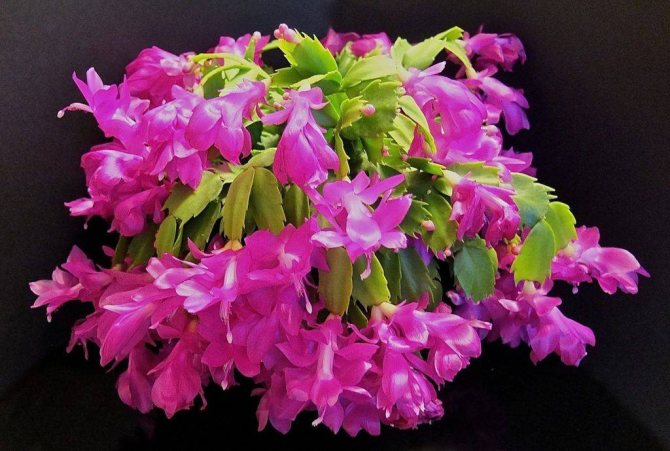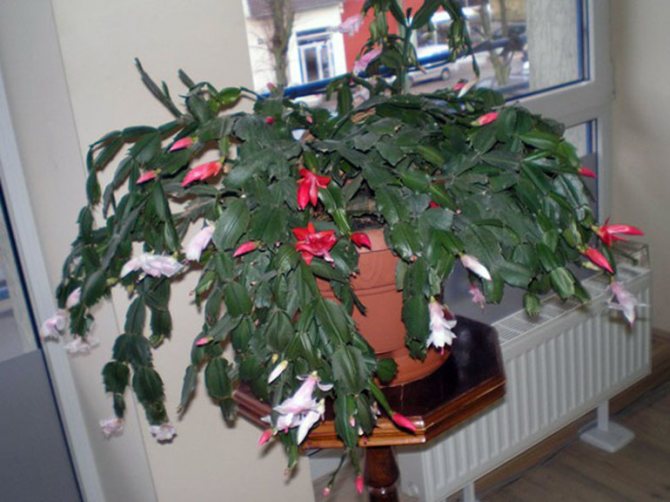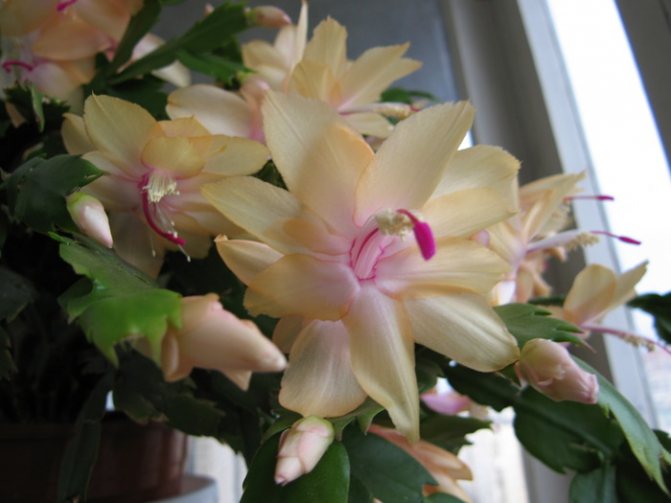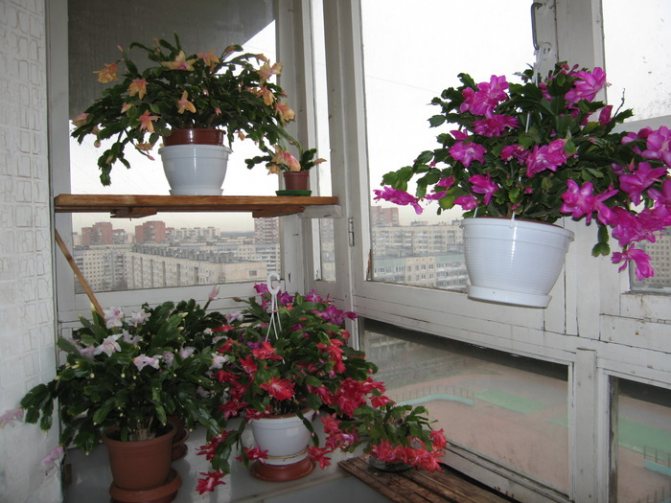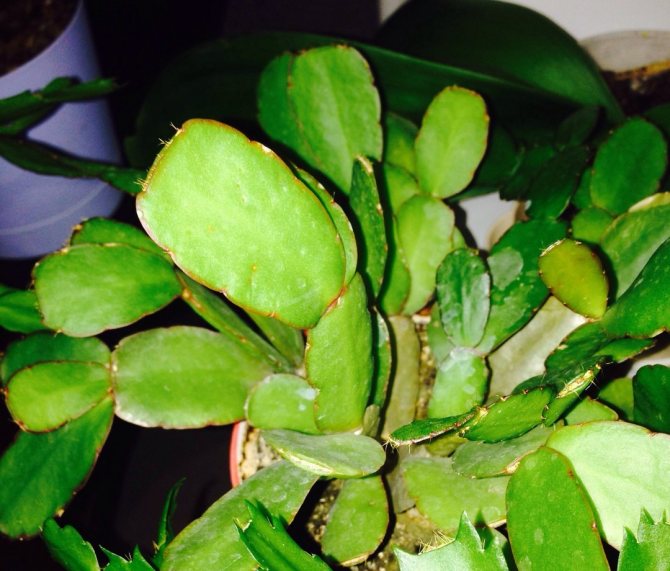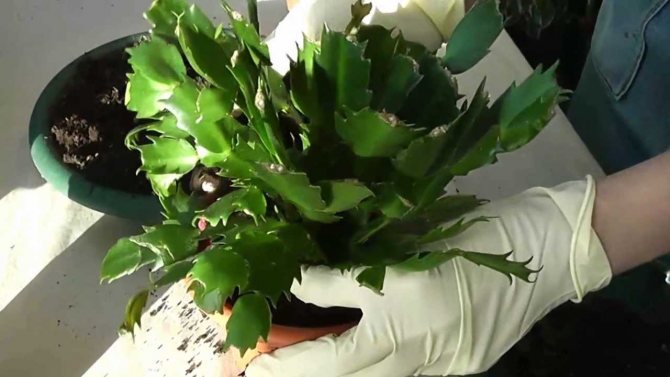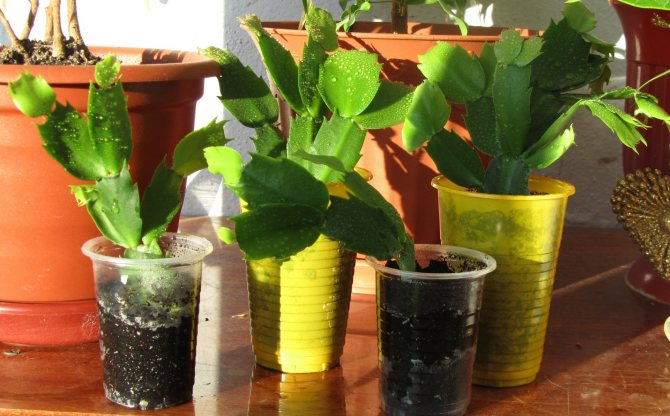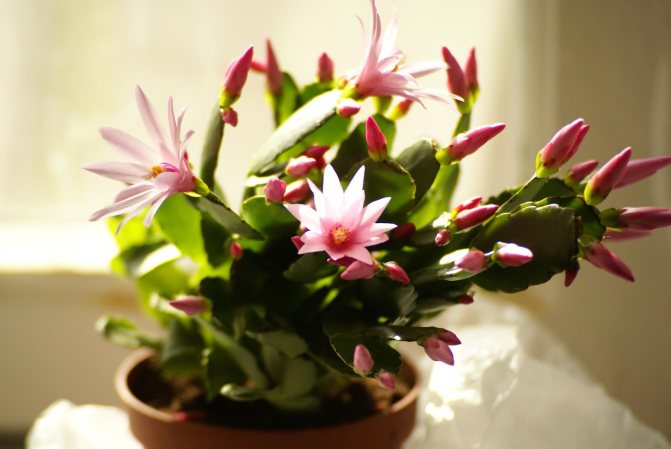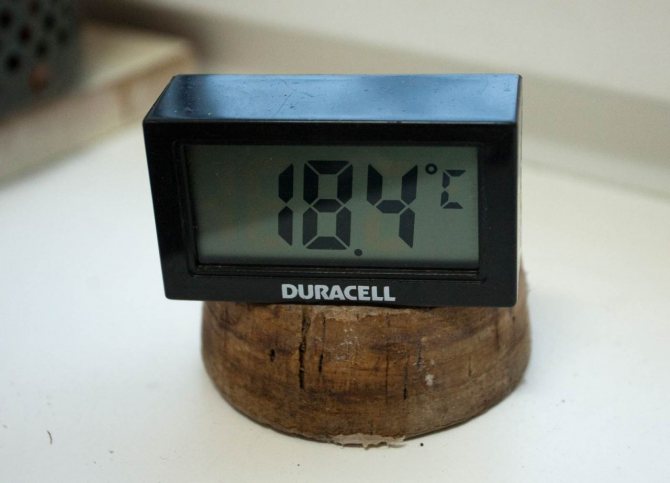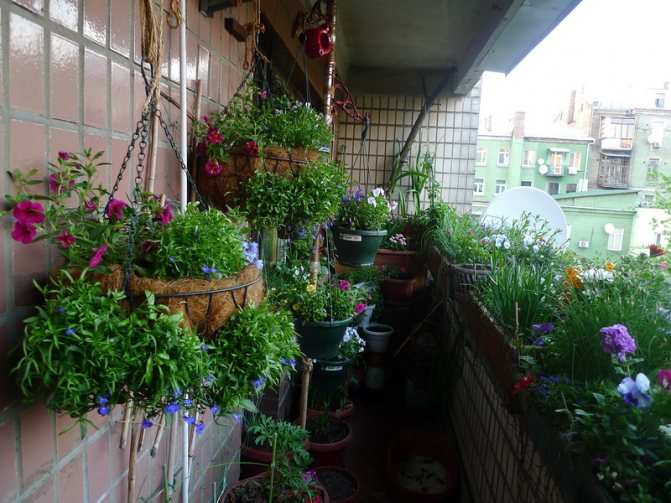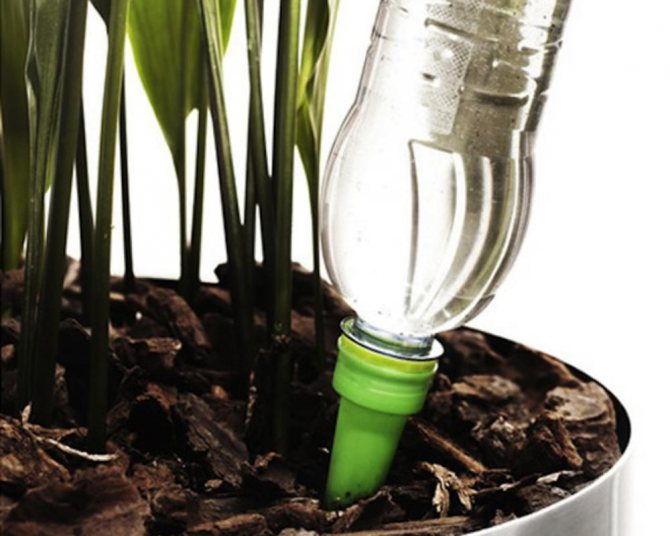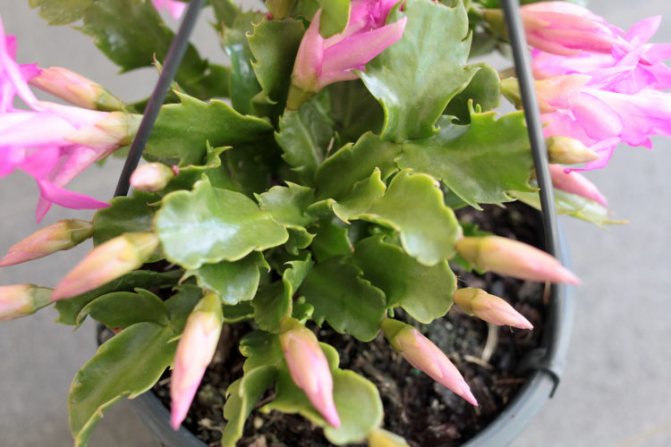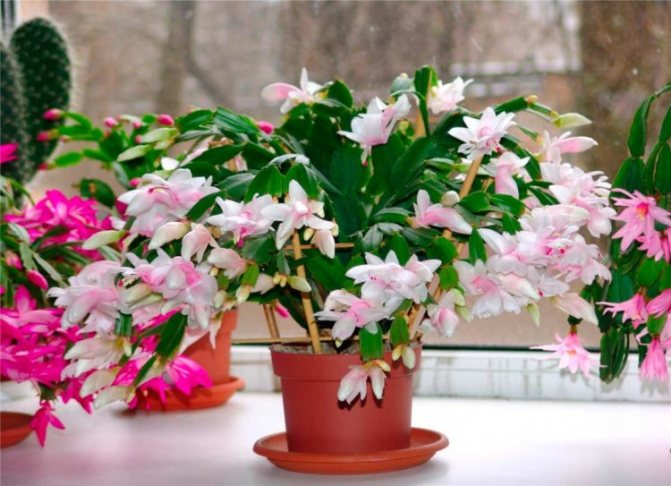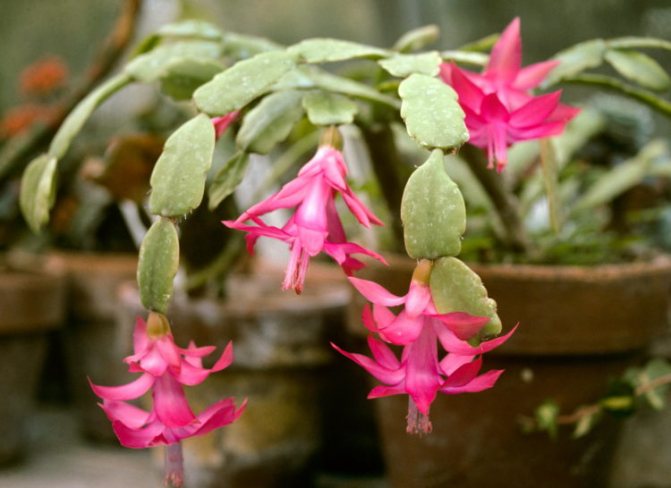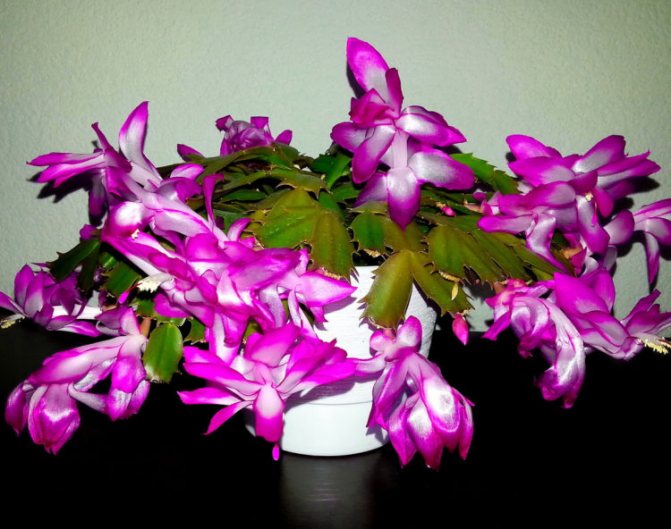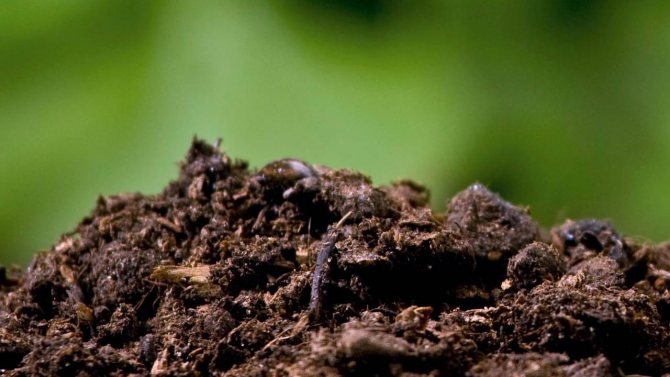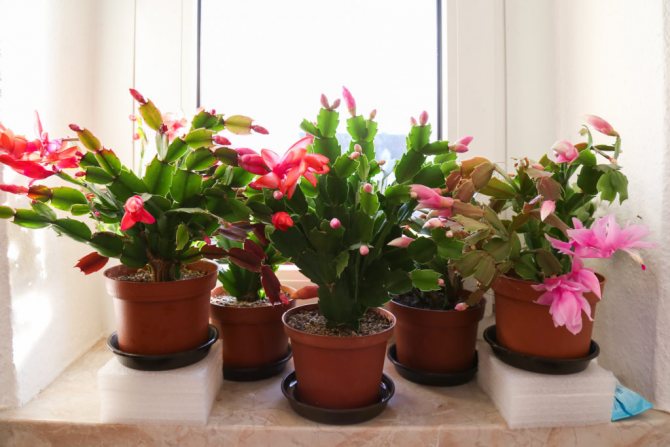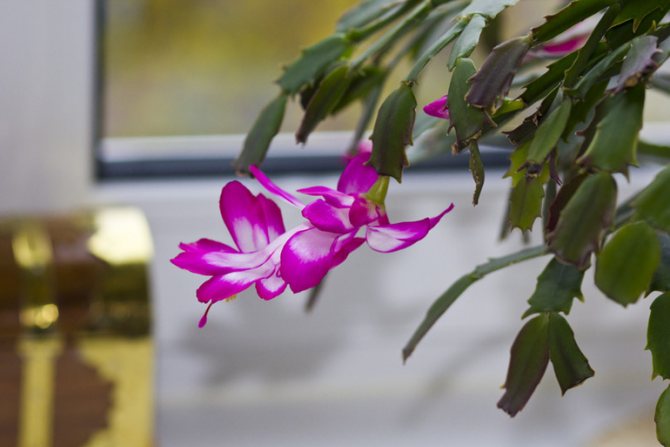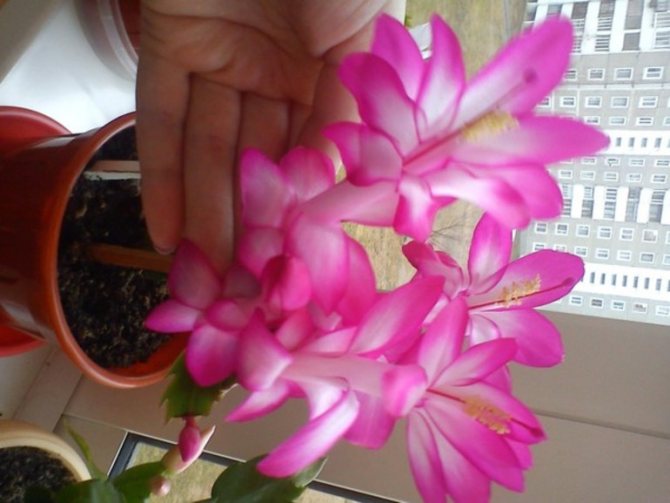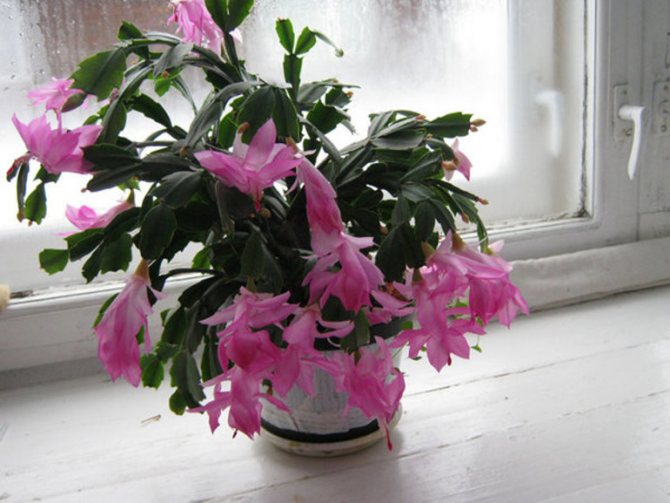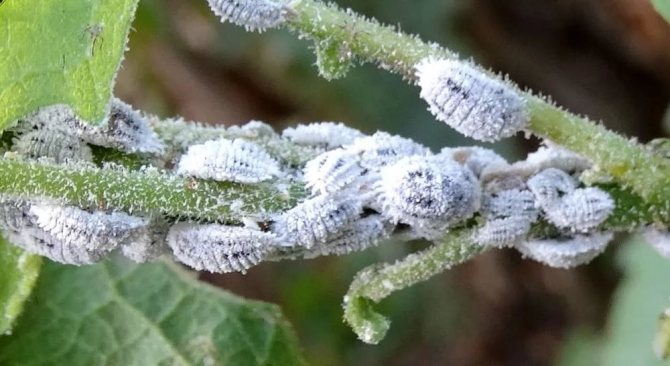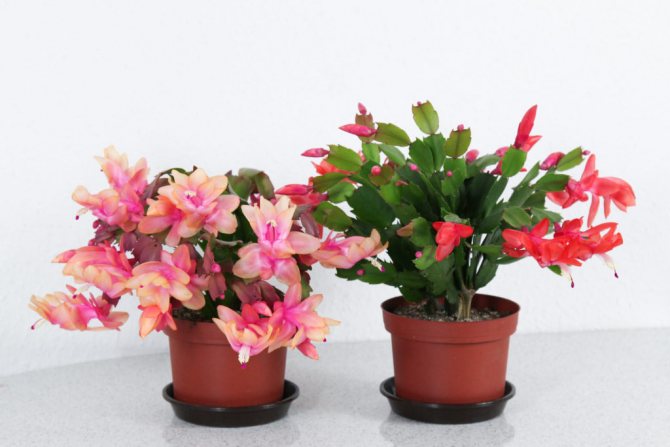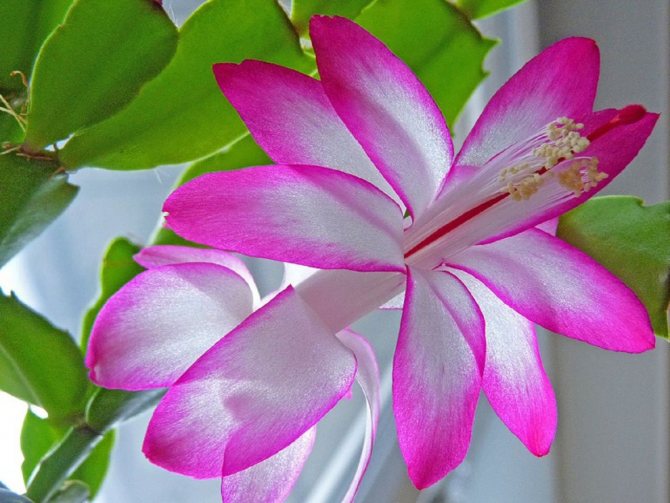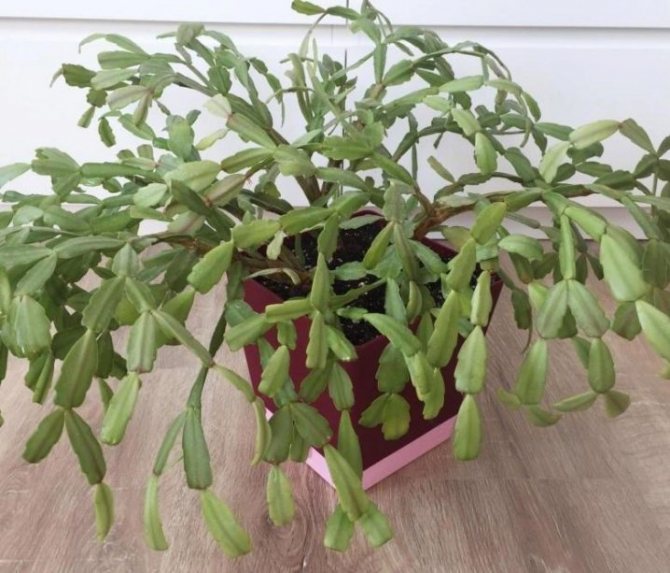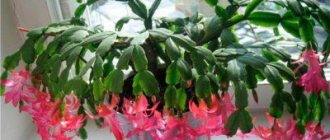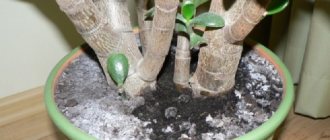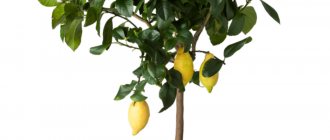Description of the Schlumberger flower
This indoor flower has a shortened stem, which makes it look like a standard plant. From the stem there are many branches, which consist of zigzag links. Each link gives 2 or 3 more links. The result is a round ball with ampelous hanging stems.
Actually, these links are, in fact, the leaves of a flower. With good care, almost all leaves on the periphery of the bush will bud. They bloom almost always at the same time. And then the spherical bush turns into a luxurious blooming bouquet. Initially, the variety had only pink flowers, but breeders have created shrubs with white, red and, with a carmine tint, crimson flowers.
Morphology
Zygocactus has no leaves, their functions are performed by flat green shoots. Shoots consist of segments with sharp edges - this is a specific morphological feature of the Decembrist. The green color of the shoots is given by the chloroplasts in the cells, in which the process of the formation of organic substances takes place.
The flowers of the Christmas tree are actinomorphic, with strongly bent petals, so the stamens and pistil are not covered by the perianth. The color of the petals is usually dark pink, but bred varieties can be white, crimson, red, burgundy.
If Zygokactus Decembrist blooms
There are many signs associated with the opening of Schlumberger's buds. Some are good and some are not. If the Decembrist bloomed, then the signs associated with flowering in the due time, they say that the coming year will be joyful and bring good luck.
When the flowering time is violated, then it threatens with trouble. But it is not for nothing that nature has determined its growing territory for each of its creations. And all a flower needs is to make it feel in your home just like in its native places.
Good omens
Superstitions that connect events in a person's life with the time of flowering of Schlumberger's zygocactus are based on long-term observations of him.
- If it bloomed in December, it means that prosperity and peace reign in the family.
- The opening of the buds in the early days of the month means that next year will bring a lot of positive events.
- When flowers open ahead of time, then this is a sign of an imminent new acquaintance.
- If a month or more remains before the deadline, but it smells fragrant, then you can soon expect an inheritance, a wedding or an addition to the family.
According to the classification, this plant belongs to zygocactus, but practically has nothing in common with them. Cacti carry sharp energy, and the Decembrist is gentle and affectionate. He subtly feels the mood of the people around him and empathizes with them. You can keep him at home so that there is someone, to tell about your problems, or about the joys in life.
When it is good in the house, the flower transforms positive vibrations and gives them to people in the form of an abundance of buds. You cannot be angry and selfish near this plant. He awakens in people kindness and compassion for fellow people. A person tries to become a purer soul, nobler and more sincere.
A flower has a beneficial effect on a person
For people associated with creativity, blooming on time will mean that they have to make new discoveries, find interesting solutions to creative daring. The plant is very beneficial to children. It helps them, on a subconscious level, to develop spiritually. Cleans the body of a growing child from the influence of the environment, which can be detrimental to tender childhood.
Bad superstitions
If the Decembrist bloomed in April, then signs say that you need to prepare for a difficult year. This could be:
- lack of money;
- problems at work and at home;
- complete collapse of hopes.
The rapid growth of shoots and buds in April may be a signal that the body, of one of the family members, is fighting the disease.
His residence in the house is associated with scandals between spouses and is considered the reason that marriages break up. Girls remain old maidens who do not know male tenderness. This is one of the reasons why it is often grown in offices, schools and other non-residential areas.
A belief in which the death or illness of a flower is associated with the death of a person can be declared very scary. A dying plant, as if dragging along, into oblivion, the living, depriving them of a chance for life. If a superstitious person grows this plant at home and always fears that it may get sick or die, then wouldn't it be better to abandon it altogether.
The plant is very sensitive to the effects of negative energy. If at the time when the buds are formed, a person carrying evil or hatred appears in your house, then the delicate Schlumberger cactus will shed some of the buds and may begin to wither. He will take on all the negativity directed at you and will start to hurt. But when the ill-wisher disappears, then the flower will seem to have a second wind: it will come to life, grow new leaves and bloom. And you will know for sure which of the visitors to your home wishes you harm or burns with envy, looks with disdain or tries to disrupt the peaceful course of your life.
Common mistakes when growing
Belonging to cactus does not mean that the care of the Decembrist can be carried out in the same way as for ordinary cacti. Some owners of this plant think that it is enough to water it occasionally and no longer participate in its life. This is a strong misconception.
Due to constant lack of moisture the Decembrist will become lethargic and unlikely to bloom. And from abundant watering, the plant will begin to lose foliage. Therefore, it is important to observe the required watering regime. Another common misconception is that the Decembrist grows more actively in large pots. This logic works with most plants, but not with the Decembrist. In its natural environment, the plant has a weakly developed root system and is attached to trees.
Big pot stimulates the plant to develop a root system, but in the end the roots will simply come to the surface. This can also be the reason for refusing to bloom.
The depth of a suitable pot can be selected based on the height of the stem. A container with a depth of 3 times less than the stem of a plant is suitable.
Also, during the flowering period, you should not leave the flower unattended. When setting buds, you need to make sure that the Decembrist does not acquire too many of them. If 4 or more buds have formed on one branch of the Decembrist, it is worth removing some of them. With a large number of buds, the plant simply does not have enough strength to bloom., it itself will begin to throw them off.
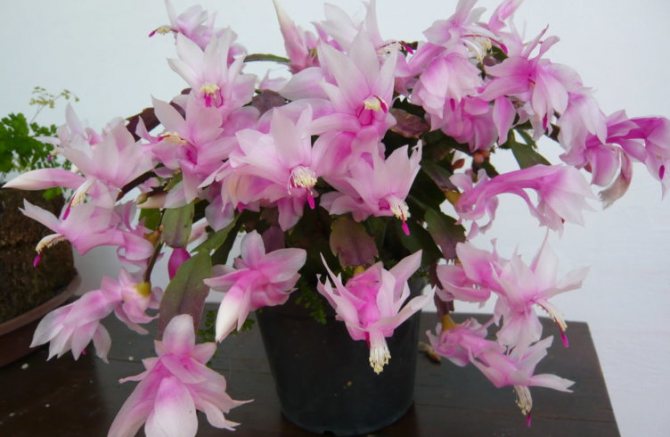
One of the brightest representatives of the genus Zygocactus and Epiphyllum is the Decembrist Schlumbergera, which can often be found on window sills. He fell in love with the abundance of beautiful flowers at the ends of the stems. Beautiful orange, pink, white, purple and red lights in the green mass of shoots look very attractive. Flat jointed branches have no thorns.In the wild, they are found in tropical forests on trees; the plant is native to Brazil. The Decembrist appeared in Europe in 1816 thanks to the collector Allan Cunningham.
Given the genus of growth, it is comfortable in high humidity conditions. Next, we will talk about why the Decembrist does not please with abundant flowering, and what needs to be done for this.
The flowering of the plant begins in the month of December, which is where the name comes from. But often the Decembrist blooms in spring.
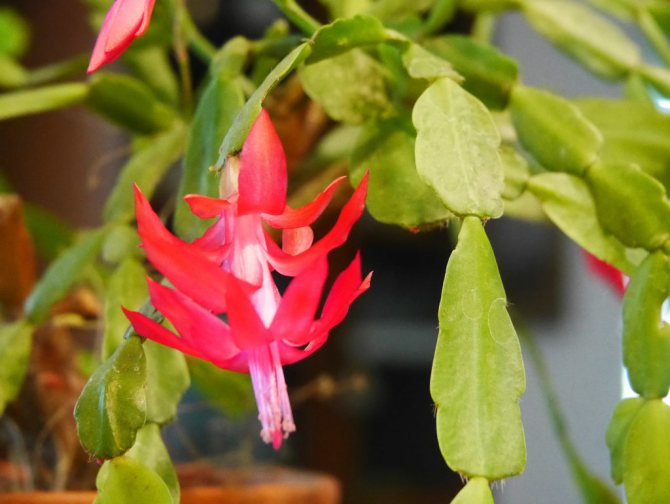

Signs and superstitions about the Decembrist
Perhaps the most terrible sign associated with the Decembrist indicates death in the house. If the flower suddenly dies, it means that one of the household members will soon die. Psychics and magicians believe that in this case, the Decembrist becomes a person's guide to another world. That is why many especially impressionable people are afraid to populate this plant in the house - few people want to know when he or his relative will die.
However, Schlumberger also gives other signs, can predict good events for their masters.
- If the Decembrist bloomed in time, at the end of December, then the life of the household is a full cup, and only happy events await them next year. And if the first flowers appeared exactly on New Year's Eve, then you can't imagine better omens: prosperity and joy promise such an event for all the coming 365 days.
- If the Decembrist bloomed a little earlier than the due date, it does not matter, such a "heyday" portends unexpected meetings and acquaintances, bright events - from the fulfillment of a cherished dream to a suddenly announced inheritance.
- If the buds appeared in mid-autumn, then the family can wait for an addition.
- Schlumberger gives creative people special signs: blooming on the eve of Catholic Christmas will mean success for them in new projects, and a muse will visit someone.
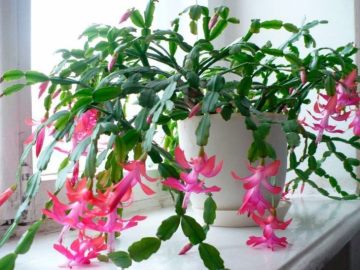

Unlike the signs, the superstitions born around the Decembrist are not so positive.
- So, if the Decembrist released flowers not in December, but in the spring, misfortune can happen in the family: and these are not only serious conflicts at work, at school or college, but also discord in the family, health problems of households and lack of money.
- If the Schlumbergera has not bloomed even once in a year, while she was cared for and watered well, then the household will face a difficult period in life. Problems will pour down on the family one after another.
- If the leaves of the Decembrist suddenly abundantly covered the stem in the spring, then someone from the family was struck by a serious illness and an urgent need to fight it.
Top dressing and watering
Some growers do not pay enough attention to green pets and do not transplant them into new pots. Without changing the substrate, which is depleted in 3-4 years, the plant stops receiving nutrients. In the fifth year, such florists wonder why the Decembrist does not bloom. An urgent transplant will not help, the optimal time is from late January to mid-February.
As with many houseplants, Schlumberger needs medium-brightness lighting, not the scorching sun with its direct rays on a hot afternoon or full shade with twilight. Window sills on the north or east side of the house are the best option.
Despite the fact that the Decembrist is a real blooming cactus, it needs to be watered often, but not abundantly. He loves spraying too, but doesn't respond well to bathing. Watering must be combined with top dressing in the spring and summer season.
If the Decembrist has not bloomed for several years, in this case, you only need to do one thing: urgently change the pot, select the optimal substrate and look for a suitable place for it in the apartment.
The soil for planting should consist of loose garden soil, sand from the river bank, humus and a small amount of peat. It is also useful to add sod land. In a flat, low pot, the Schlumberger will feel very comfortable and will grow into a lush, thick and blooming interior decoration.In a large container, all the forces of the plant will go only to the development of the root system, which will also interfere with flowering.
Biological product Epin: composition and instructions for the use of fertilizers
When should the Decembrist bloom at home
The beginning of flowering when grown in native conditions falls on the end of October. This process ends in early spring.
Growing a culture at home, the first flowers can be expected closer to the winter season. In the case of abundant moisture in the soil from mid-spring, you can wait for the flowering of plants a few weeks earlier.
How many times a year can a plant bloom?
Flowering occurs once per year.
The decorative culture is gradually preparing for this period, passing through the stages:
- vegetation;
- rest;
- flowering;
- repeated dormancy, at which the plant begins to recover.
When and how Schlumberger blooms
A tropical cactus, leading an epiphytic lifestyle, blooms in its homeland in summer. Since Russia is in the northern hemisphere relative to Brazil, the budding period falls in the winter months. In November, buds appear, which gradually open the corollas, replacing each other. For 2-3 months, you can contemplate the abundant flowering of exotic, after which the plant is satisfied with another period of dormancy of 8-12 weeks.
It is interesting! Some zygocactus sometimes bloom again in spring.
Annual flowering of the Decembrist
His ability to delight people with unusually lush and truly beautiful flowers in the midst of snow and frost can cheer up all family members.
The Decembrist creates a positive atmosphere in the house. Its capabilities testify to resilience, ability to cope with difficulties and positive energy.
Therefore, people have a lot to learn from him. The presence of a plant in the house gives strength to get out of life's difficulties, to help each other, and also not to be afraid of anything.
A variety of beliefs are associated with what the plant blooms for.
Not every feature is an empty superstition. It is worth listening to it and trying to understand what lesson will be useful to learn from it.
It is advisable to monitor the relationship between spouses, children, and communication with friends at home. It is also necessary to monitor the health of all family members, including pets.
In addition, in addition, you need to talk in great detail with each of the relatives about their main life problems. It is possible that someone has plunged into a deep depression, but does not want to upset others.
Decembrist omens and superstitions
The signs associated with the Christmas tree are mainly associated with its flowering.
Good omens
It is believed that the Christmas tree is an affectionate and delicate flower that feels the mood of the household. He will rejoice if you tell him about happy events in life, and empathize if you complain to the plant about problems.
The Decembrist is suitable for those families with children. The flower loves babies very much, protects them from the negative environment, helps to develop spiritually.
A very good omen is the flowering of the Decembrist in late autumn and winter:
- Blooming a month earlier Christmas
- to add to the family, wedding or even inheritance. - The buds have blossomed ahead of time
- wait for a new acquaintance. - Flowering in early December
- there will be many good events next year. - Blooming Christmas tree in December
(at his usual time) means that everything is fine in the family and at home, there is no need to worry about anything.
Bad superstitions
Superstitions about the Decembrist are very bad, very negative. They are all connected with the flowering of the Christmas tree in the spring, namely in April. Blooming in spring means:
- problems in the family and at work;
- collapsed plans;
- lack of money;
- illness or even death of a loved one.
I don't know where all these bad omens and superstitions came from, but, in my opinion, the spring flowering of the Decembrist can be explained something like this:
- In winter, the plant did not have enough lighting.
- Improper care.
- Lack of a dormant period.
- The plant was transplanted in autumn, it took a long time to adapt and therefore the formation of buds began late.
- The shoot of the flower was planted in the fall, and by the spring it took root, grew and blossomed.
Isn't it true that these reasons are more real and optimistic? Learn how to properly care for Christmas
Another superstition about the Decembrist is that the flower is a "muzhegon", and the girl who grows it will never marry.
There are too many domestic plants for the signs and superstitions of the "muzhegon". If you believe them, then almost every second woman should never have gotten married, because in almost every house and apartment various vines, ficuses, and Rozhdestvennik grow.
Having studied the superstitions and signs of the Decembrist, let's find out what the eastern sages say about this flower.
Influence of seasonality on a plant
The fact that the homeland of the Decembrist is distant Brazil has left its mark. In the countries of the Eurasian continent, its seasonality looks completely different and unusual for us. Depending on the time of year, you will need to take care of the Decembrist in different ways. Compliance with these differences is important so that the Decembrist has time to restore and accumulate strength for the new flowering season.
The period of flowering and the most peak activity falls on the time when the calendar is late autumn and winter. In this cold time the Decembrist requires constant spraying of the buds... This will provide him with the necessary moisture. When the plant blooms, you do not need to stop spraying. It is important to monitor the moisture content of the soil and avoid dryness. You will also need absolute rest for the pot and no feeding.
By February, the plant sheds flowers and stops blooming. If the plant does not get rid of dried flowers on its own, you can help him: gently tear off the last petals and remove the remnants of the inflorescences. Until April, the flower should be moved to a cooler place and watered once a week.
In April, you need to make the first top dressing. - an exhausted flower needs to restore the spent strength. Until June, once a month, fertilizer must be applied to the soil. The portion required at this stage is half the size recommended by the manufacturer. The Decembrist needs to provide partial shade. It is necessary to continue spraying it, from time to time you can wash the leaves with settled warm water.
After feeding, the plant is ready for transplanting or reproduction. Such actions should be carried out at the end of April or in May.
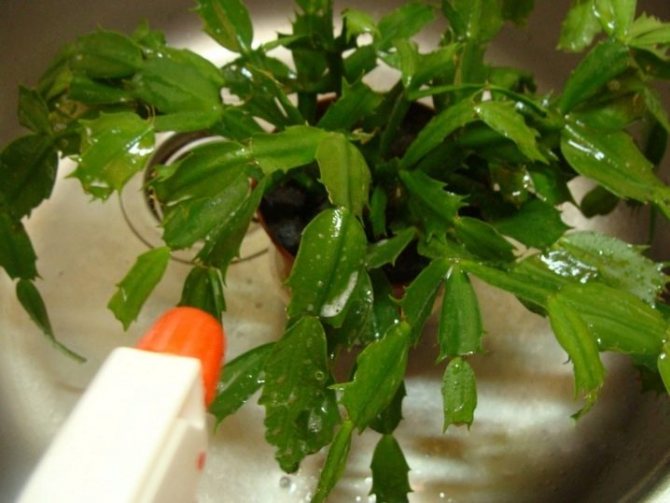

A young plant needs a transplant every year. At this time, the Decembrist is actively growing and "pulling" everything he can from the ground. An adult plant needs only one transplant in a five-year period.
In June, the plant must be moved to fresh air. You can take it outside, or you can put it on the balcony. The main thing is that the plant is not under the scorching sun. It would be better to place it in a shade or a place where only scattered, indirect rays can reach it. You also need to protect the flower from rain.
During this period, the rhythm of watering changes - you need to water only when the soil begins to dry out. Feeding is also becoming more frequent - now the plant needs to be fed 2 times a month, each time giving a full portion of fertilizers. In such conditions, the Decembrist will live until September, when his period of rest begins. This month, the flower needs to be moved back to the room, where it will live before flowering.
Until November, the room temperature must not exceed 14 ° C and cannot drop below 10 ° C. Top dressing should be stopped, and watering should be reduced even more. At this time, the frequency of watering can be up to 1 time in 2 weeks. Flowering begins in November. Therefore, until December, gradually raise the temperature to 15 ° C and resume more frequent watering. The main thing is not to do this abruptly, so as not to injure the flower.
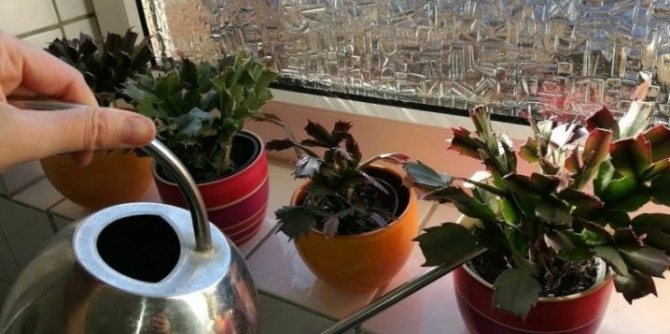

Energy in the house
Some people are so afraid of accepting that they try to put the Decembrist on the stairs or in the hallway.
If the plant suddenly stops looking viable and full of vigor, you just need to look around. With the establishment of all spheres of existence, it returns to its previous form.
In general, it is noticed that the Decembrist has a benevolent relationship between family members. Therefore, if the marriage went wrong, it is a good idea to acquire such a flower. It helps to normalize the energy in the apartment, softening the souls of people.
He will immediately predict negative events and allow you to relax, predicting the upcoming streak of success.
Therefore, the Decembrist is a conductor of higher forces that are trying to prepare a person for possible unexpected turns in his life.
For what reason does he throw off the unopened buds?
- The fall of the still unopened buds can cause the death of the roots during hypothermia or drying out, acidification of the substrate. It is also quite possible that the soil lacks nutrients.
- A lot of buds have set, and the plant cannot provide all of them with water. Therefore, the Decembrist drops some buds, even if they have not yet blossomed.
- Abundant hydration of the flower.
Important! Do not flood the flower too much, the earth should dry out, otherwise the roots will be moistened. - Temperature change. Schlumberger is a very whimsical plant, and the temperature is below 16 degrees, or constant drafts can contribute to the fall of unblown buds.
Why the Decembrist omens bloom
Florists often grow a Christmas tree in their homes. It is believed that these flowers feel the changes that must occur in the fate of the owner. A large number of signs are associated with the flowering of a plant.
Below are the most popular ones:
- The decorative culture blooming on time testifies to the cozy and wonderful atmosphere that reigns in the apartment. Husband and wife are able to come to terms with each other's shortcomings, children grow up in love and joy. In the case when the plant begins to bloom in early December, you can be sure that the next year will be especially happy and joyful. Pleasant events will systematically delight the owner of the house.
- When the Decembrist blooms in late autumn, we can talk about the upcoming pleasant acquaintance. The florist will soon expect pleasant changes in life and an improvement in his financial situation.
- Blooming in the middle or at the end of winter may indicate an impending disaster. Serious quarrels and disagreements between spouses, serious illnesses or problems at work are possible. The plant blooming during this period speaks of strained family relationships.
- Late flowering signals a worsening financial situation, serious business problems.
- A withered decorative culture signals a serious misfortune, the death of a loved one, an accident.
The Decembrist flower has long been considered a kind of signaling device that responds to minimal changes in the biofield in the house.
When a person is sick in the house, the owner of the flower begins to carefully care for the plant. If the decorative culture does not start to wither, then the person will survive.
Diseases
Epiphytic cacti, including Schlumberger, Ripsalidopsis, are susceptible to the influence of a number of pathogenic microorganisms and bacteria that cause serious diseases. The most common:
Fungal
Schlumberger, fusarium. Exc. Fusarium oxysporum.
Fusarium cladophyll rot, is a type of fusarium. The causative agent is Fusarium oxysporum.
Symptoms: Infection appears at the edges of the cladodia. Lesions are usually orange, light and dry, while sunken.Orange spores of the pathogen are visible in the lesions, they easily spread through water or air, since they are lightweight. Dying off of roots and cladodes is noted during prolonged illness. Schlumberger and Ripsalidopsis are susceptible to Fusarium oxysporum.
Schlumberger, cladodes rot. The causative agent is Drechslera cactivora.
Drechslera cladophyll rot, or Helminthosporium cladophyll rot, - rot of cladody. Exc. - Drechslera cactivora.
Symptoms: black-dark, deep lesions from 1 mm to 1 cm wide on the cladodia (leaves) of the epiphytic cactus. The lesions are round in shape and can be located both above and below ground level. Black spores of the fungus are visible in the lesions, giving them an indistinct appearance. Rhipsalidopsis are very susceptible to Drechslera cladophyll rot. Schlumberger people are moderately susceptible.
One of the easiest ways to distinguish between Fusarium cladophyll rot and Drechslera cladophyll rot is by observing the color of the spores, as in Fusarium they are orange, while in Drechslera they are black.
Schlumberger, late blight. Exc. Phytophthora sp.
Pythium and Phytophthora root and stem rot, is a type of late blight. The causative agent is Pythium and Phytophthora spp.
Symptoms: Foliage of plants infected with Pythium or Phytophthora spp. has a dull gray-green hue and may wither. The stems rot on the soil line, the tops of the plants decay. The roots are dark, soft and few in number.
Bacterial
Soft rot. The causative agent is the bacterium Erwinia spp.
Symptoms: A blackened, moist, slimy lesion usually begins in the soil line at the base of the plant and progresses to the top of the cladodia and other plant segments. Plants wilt, decay and often die.
Treatment
For the treatment of fungal diseases, systemic and contact fungicides are used. As a rule, the most effective are systemic ones (penetrating into plant tissues through the root system), for example Fundazol. From contact fungicides, Fitosporin, a ready-made Bordeaux mixture, can be used. During treatment, the diseased plant is kept away from healthy plants, in a dry place, sunlight can also have a beneficial effect. The prognosis is not always favorable, in case of irreversible damage, plants and soil should be destroyed in order to prevent the spread of fungal spores, vegetation vessels (plant pots) should be disinfected or destroyed. It is permissible to graft a healthy part of the plant by pretreating it with a fungicide.
Features of the flowering period of the Decembrist
During the blooming of the buds, the Christmas bush is covered with bilaterally symmetrical flowers of various colors (most often lilac, red, white, pink, purple, orange). The flowers are located at the ends of the jagged shoots of the plant.
In the conditions of an apartment, the buds of the plant are not very large, although at home, in the tropics of Brazil, flowers can be up to 8 cm in size.Without proper care, it is impossible to achieve blooming of inflorescences in the culture. This will help the preparation of the zygocactus for this period and the creation of optimal conditions for it.
Did you know? The Christmas tree is a long-lived plant, because with proper care, the culture, being in one place in an apartment, can safely grow and develop up to 20 years, and in a greenhouse or botanical garden - up to 150.
Influence of the seasons
In order for the plant to bud on time, it is important to provide it with proper care throughout the year, and not just during the flowering period. In this case, the culture will be able to accumulate strength during dormancy and give beautiful buds for Christmas.
The activity of the plant and its flowering always occurs at the end of autumn and winter. At this time, the plant needs regular spraying - it needs high humidity and warmth. The ground should always be wet or dry. At the same time, the pot is never moved at this time, no top dressing is applied.
Let's take a look into the bedroom
In no room of a house or apartment a person needs positive energy and clean air so much as in a bedroom. From what kind of indoor plants he is going to keep and grow there, depends not only a good rest from daytime worries, but also health and intimate relationships.
It is undesirable to put plants with a large mass of leaves in the bedroom: monstera, ficus, fern. In the dark, they will intensively absorb oxygen, which the inhabitants of the house already need. Flowers with strong aromas (lilies, gardenias, orchids, hydrangea), as well as those that emit poisonous fumes: oleander, alocasia and many others listed above, are also inappropriate in the bedroom. Even geraniums can cause headaches if kept in the bedroom on a south-facing windowsill.
If family members suffer from asthma or allergies, it is better to avoid plants in the bedroom altogether. Constantly moist soil in flower pots, spores of some plants, molds, possibly present in a humid environment, do not in the best way affect the well-being of such patients.
As for the recommendations of Feng Shui, according to its canons, it is undesirable to keep in the bedroom:
- tall plants with spreading leaves;
- tough and thorny cacti and succulents;
- drying and diseased specimens.
What flowers does Feng Shui teach you to keep in your bedroom? These are soft and delicate specimens with thin leaves, citrus fruits, miniature varieties of ficuses, violets, aloe.
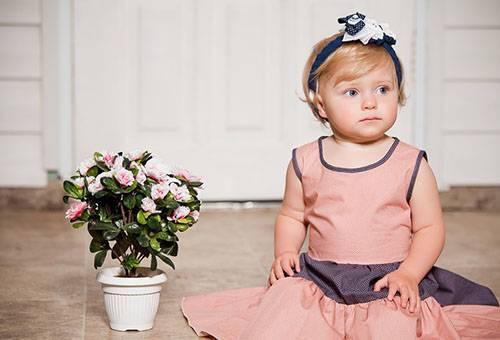

The requirements for colors in the children's bedroom are the same, only reinforced by safety measures. You cannot put there:
- poisonous varieties of indoor flowers;
- specimens with a strong odor;
- cacti, milkweed and succulents;
- lianas and ampelous plants;
- flowers that strongly emit carbon dioxide, with large leaves;
- allergens.
When purchasing or growing indoor flowers, you need to pay attention to their properties: safety, absence of allergic danger in the form of fungi, mold, spores. It is strictly forbidden to keep poisonous specimens in a house where there are children.
Especially carefully select green decorations to place them in the bedroom, in the children's room. If folk signs and superstitions seem worthy of attention, then you should choose flowers, focusing on them. No matter where flowers are placed to decorate rooms - in the kitchen, living room or bedroom - there is always a large selection of plants that do not pose a threat to health and energy balance.
Pests and diseases
If no drastic measures help, and the plant still stands without bright buds, it is necessary to inspect it for the appearance of pests or diseases. They are not always visible to the naked eye, so it is worth taking a closer look. Most often, the Decembrist is amazed:
- spider mite - small, dot-sized insects of whitish, yellow, red or brown color, covering the lower surface of the leaf plates;
- late blight, fusarium - fungal lesions that completely destroy the plant, weaken the root system and appear in the form of slippery, sticky spots on the flower;
- mealybug - it can be seen on the joint parts of the leaves in the form of white lumps or clots;
- scabbard - plaque on the plates in the form of brown or rusty streaks and spots visible to the human eye (adhering to the cuttings of adult parasitic insects);
- a red tick - it looks like a rusty or brown blotch on the plant, completely destroys the flower, the leaves gradually fall off.
Pest control is carried out using insecticides. In flower shops, most often they offer "Actellik" or "Fitoverm" - the most reliable means to destroy unwanted parasites in 1-2 treatments. As antifungal compounds, flower growers recommend washing with a solution of laundry soap or antiseptics.
It is better to remove the damaged parts of the Decembrist by carefully cutting with sharp scissors. First, it can prevent further active spread of pests. Secondly, this way you can protect the indoor flowers adjacent to the plant from the same infection.
The orchid has faded: what to do next so that the peduncle blooms again
What to do for the Decembrist to bloom
The appearance of flowers is preceded by the restriction of access to light for 12 hours a day, a darkening procedure is used. The procedure begins in October by covering the plant with an opaque bucket or pot for 6 weeks. If the pot is in a dark room, there is no need to cover the plant. You need to close the windows tightly so that the plant does not have access to artificial light.
In the process of darkening the Decembrist, we provide optimal conditions for growth - a temperature of 21 ° C, good lighting and balanced watering during the day. If the conditions are met, the Decembrist will reward with lush and beautiful flowers.
How do you make it bloom?
In the fall, take the Decembrist out to the street or veranda for about a month. Protect it from rain and direct sunlight. Do not water. Leaves can stick. Make sure that the temperature does not drop below + 10 °. Return the plant to the room. In a lighted place, it should be every day for no more than ten hours. Flowers will appear in 50 days.
Attention! You cannot turn and rearrange the pot to another place. The formed buds may fall off.
At a room temperature of + 17-19 °, the flowering period is extended.
Care before and after flowering
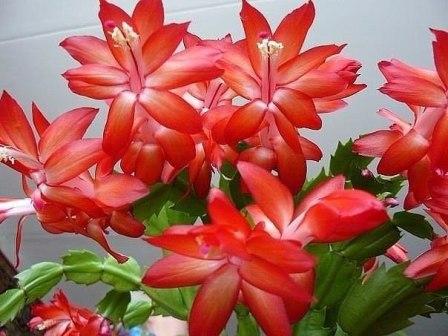

Flowering depends on proper plant care at all times.
During the budding period, watering is required once every 3-5 days. You can dissolve a little fertilizer for flowering plants in water. The soil should not dry out.
During flowering it is necessary:
- good lighting (direct sunlight is also possible, in winter they will not bring harm);
- regular watering;
- prevent stagnation of water in the pallets;
- high air humidity.
After the end of flowering, it is recommended to pinch the shoots by hand (do not use scissors) to stimulate the growth of new shoots. Move the plant to a cool room, reduce watering. Leave until March. Do not transplant during this period.
Transplants are allowed in March. A young flower is transplanted annually, then once every 3-5 years.
In the future, regular watering is required. The water collected in the pan should be drained. Do not use hard or cold water. The Decembrist does not like the drought.
It is important to choose the right pot when transplanting. It should be wide and shallow with holes provided. Drainage is placed at the bottom: expanded clay, crushed stone, small pieces of brick. Suitable soil for orchids mixed with soil from the garden. You can make it yourself from sand, perlite, fertile soil and peat in a 1: 1: 1: 2 ratio and add a little wood ash.
The plant is propagated by cuttings consisting of 2-3 segments. To do this, they are pinched off from the stem, kept for two days in a shaded place and planted in peat soil. Use plastic cups. Then they are wrapped up, periodically ventilated. The optimal temperature regime is + 18-20 °. Works are performed in March-May.
Since June, the zygocactus is moved to the veranda or street. Shade. Water regularly, feed 2 times a month.
In September-October, watering is reduced, feeding is stopped. They select a place for the Decembrist, where the ambient temperature is 10-14 °. With the beginning of heating in the apartment, you should not keep it near heating appliances.
In November, a permanent place is selected for the plant, watering is increased, and lighting is increased. The optimum temperature of the content is not lower than 15 °.
When the Decembrist blooms
In comfortable conditions for the plant, zygocactus can give its first flowers in the last week of November and ends up budding only in January. In some cases, the plant may then bloom again, but this does not happen often. In order for the Decembrist to bloom regularly on time, you need to provide him with optimal conditions.
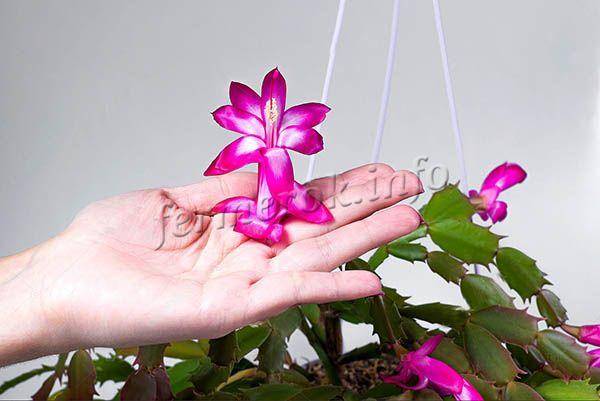

Photo of the Decembrist flower
The pot for the Decembrist should be low, but wide. The Decembrist needs a permanent place to grow, you cannot often transfer him from place to place.Watering is carried out in such a way that the soil in the pot is moist, but not dry! The plant protects itself from too low or, conversely, high temperatures
The ideal temperature for flowering is + 18 ... + 25 degrees Celsius. In the summer, it is important to provide the culture with full-fledged care (feeding, protection from drafts, sun, fresh air). The transplant is carried out in a timely manner, about once a year, because over time the soil in the pot is depleted. The flower should not be exposed to direct sunlight, otherwise burns will appear. The pot must have drainage.
Care rules
By observing certain requirements for caring for the plant, you can achieve regular flowering of the zygocactus.
Temperature requirements
It is worth noting that since March, its growth is intensified, despite this, it tolerates various temperatures well. Zygocactus is comfortable to stay in hot heat and at zero degrees. In order for it to bloom in time, before flowering in December, it is placed on a cool windowsill, where the temperature is +16 degrees.
The optimum temperature for the full growth and development of the Decembrist is considered to be from +18 degrees to +25 degrees. With the appearance of the first buds, the pot is transferred to a warmer room. At the end of flowering, it is again taken out to a cool place.
Food
- The Decembrist needs regular feeding once a month with complex preparations;
- During the period of intensive growth of shoots in September, the feeding rate is doubled, and after a month they are stopped;
- In the summer, the flower grows green mass, therefore it is fed with fertilizers for cacti. But ash is also an excellent option. Two tablespoons of raw materials are dissolved in a liter of water and poured under the root;
- It also responds well to sugar. A tablespoon of granulated sugar is added to a half liter jar of water and dissolved;
- When citrus peels remain, they are great for feeding any plant. Take one part of the raw material, pour in a liter of boiling water. Allow to stand for a day, filtering, diluted with settled water in a one-to-one ratio;
- Yeast will also become a good fertilizer, 2 tablespoons of which are dissolved in a liter of settled water, add a tablespoon of sugar and let stand for a couple of hours. Dilute with water in a ratio of 1: 5 and water the plants;
If several buds form on the plants, and they fall off after a short time, the green pet lacks potassium and phosphorus. In order to prevent such a situation, it is advisable to feed him in April.
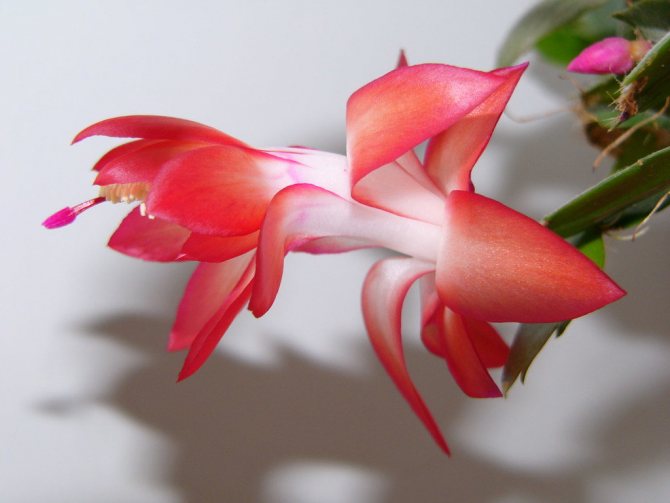

Moisture
Given the fact that the plants are native to the tropics, it needs regular spraying, especially in the summer.
Can this flower destroy the energy in the house?
Modern magicians believe that there is nothing to fear, since the Decembrist only warns of death. It does not affect the energy in the house in any way, but it is very sensitive if there is a negative. It is popularly believed that if there is this flower in the house, then in front of the deceased in the house it begins to shed its leaves and wither. For this reason, they tried not to keep the Decembrist in the house - no one wanted to know in advance about death, especially about their own. Even in the old days there was a sign that a dead flower - a Decembrist - takes a living person with it to another world. Although at the same time, many denied such superstition, believing that if there are no sick people in the house, the omen will not come true.
In fact, modern magicians are inclined to believe that the Decembrist can warn of sudden death in the house and a funeral, but he himself has nothing to do with it. But there are several other signs that can speak of what the Decembrist points to in the house.
Common growing questions
For those who are closer to practical advice on caring for Schlumberg, there are answers to some popular questions:
What is the real reason for the untimely flowering of the Decembrist? Firstly, the flowering period depends on the variety, as Ripsadolis always blooms in April, while Schlumberger - in December. In addition, the onset of flowering depends on the amount of fertilizer applied, the correct watering and compliance with the temperature regime for the plant. On which window is it better to keep the flower? Best of all, the Christmas tree will grow on the western and northern windows, as it does not like direct sunlight. If the window sill is located in the south, then in the summer it is necessary to shade the flower, otherwise it will get burned leaves. Is it true that the Decembrist has a bad effect on men? One of the superstitions says that the energy of a flower is bad for the stronger sex and that a man can "survive" from home, but there are no scientific facts proving a bad effect on the health or psyche of men.
Regardless of what we believe in, there are inexplicable things that were noticed by our ancestors and recorded in the signs that have come down to our days. The Decembrist flower has strange magical properties that can affect the life of the person who grows it. A Christmas tree has only a good effect and one should not be afraid of him, but believe it or not, everyone decides.
The benefits brought by the Decembrist
If one of the people is worried about whether it is possible to keep the Decembrist at home, then his doubts have no basis whatsoever.
He is able to quickly warn apartment owners about the danger:
Therefore, one should not be afraid of the plant, but it is better to think about what the Decembrist flower is trying to warn its owners about, in accordance with certain signs. If he languishes, then you need to be attentive to each other, and the wife should try not to quarrel with her husband.
If the plant gave buds at the wrong time, you should check all areas of your life, make peace with your enemies, get rid of fake friends, and also pray more often in church.
After that, you need to think about what signal was sent from above, as well as how you can avoid danger. In addition, it should be borne in mind that the Decembrist also promises many positive events that warn people that favorable times have come for them.
Naturally, the plant itself is not capable of controlling life and destinies. Therefore, it is better to take care of it with a vengeance, since it is so vulnerable and easily reacts to any, even subtle change in the house. Nature is never hostile to man. If he treats her anxiously, then it will be difficult for him to find a best friend.
The Decembrist does not transfer or takes away from people their internal energy, but himself, capturing it, reacts with violent flowering or loss of vitality.
Therefore, it is required to monitor the maintenance of a supportive atmosphere between family members. Then no plant will be able to break the marriage union or lead a person to death.
In good and kind hands, the Decembrist, with its lush and life-affirming flowering, will only give people an additional charge of vigor and good mood.
Post Views:
6
How clairvoyant woman Nina helps to change the line of life
The legendary clairvoyant and prophetess, known all over the world, launched an accurate horoscope on her website. She knows how to start living in abundance and forget about money problems tomorrow.
Not all zodiac signs are lucky. Only those born under 3 of them will get a chance to suddenly get rich in July, and 2 signs will be very difficult. You can go through the horoscope on the official website
Reasons for the "refusal" of the Decembrist
The Decembrist fell in love with many flower growers for his unpretentiousness, but even he, with improper care, is capable of "whims". Most often this is expressed in the refusal of the plant to bloom.
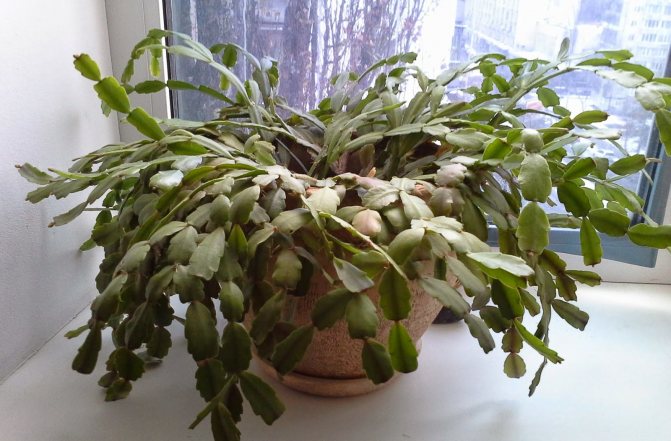

The reasons why the Decembrist does not bloom at home may be:
- improper watering;
- insufficient or too bright lighting;
- non-compliance with the temperature regime;
- lack of a rest period;
- irregular transplants;
- lack of nutrients.
If all of the above factors are taken into account, the Decembrist will definitely release buds and bloom. But failure to comply with at least one point can lead to a "strike".
Rest period organization: cheat sheet table
In order for the Christmas tree to please with lush flowering, in winter he needs to organize a holiday season. Otherwise, there can be no question of any budding. It is important to start preparing the plant for winter flowering from August.
The main requirements for the organization of the rest period are presented in the table:
| Criterion | Requirements |
| Temperature |
|
| Watering |
|
| Lighting |
|
| Location |
|
During the rest period, the Decembrist does not need additional nutrition, therefore, with the onset of August, it is worth completely stopping fertilization.
Transfer
The Decembrist does not bloom even in the absence of a transplant for a long time. It has a beneficial effect on the overall development of the plant. This is especially necessary for young flowers, as they grow quickly and constantly need nutrients. A young plant needs to be replanted once a year, and a mature one every 4 years.
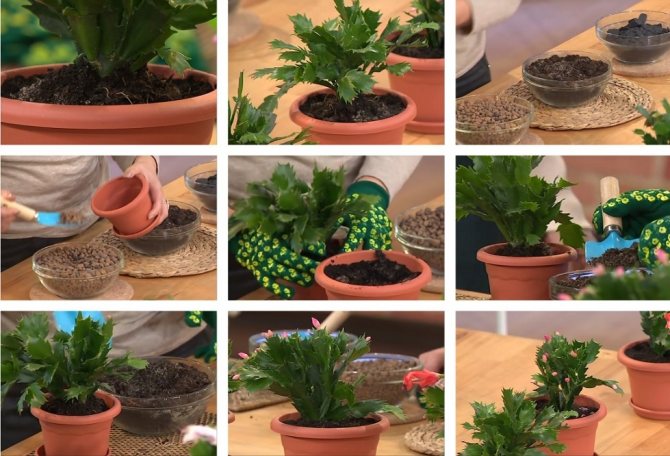

Influence of transplantation on flowering
During transplantation, you need to completely renew the soil, as it becomes less nutritious, and its structure becomes compacted. Such soil does not only pass water poorly, but also the air necessary for ventilation of the root system. The result is stagnant moisture, root decay and the appearance of diseases. In this state, the Decembrist is unlikely to bloom.
Together with the soil, it is necessary to change the flowerpot and choose its size correctly. It should be 2-3 cm larger than the previous one. The pot should be shallow and wide, since the roots of the plant are located in the upper soil layer. If the container is too large and deep, the flower will spend all its energy on growing roots and filling the pot with them. As a result, there will not be enough strength for flowering.
Pest and disease control
If the plant is sick or infected with pests, then it will spend all its energy on fighting them. The infection affects leaves, stems and already set buds, which may simply fall off before they have time to bloom.
To exclude infection, you should carefully examine the flower. Disease can be indicated by lethargic, thin, dry, or yellow leaves, or even dropping. Pests such as spider mites, scale insects or mealybugs can be found on the leaves of the plant. In this case, special drugs are used that have a detrimental effect on the source of the disease.
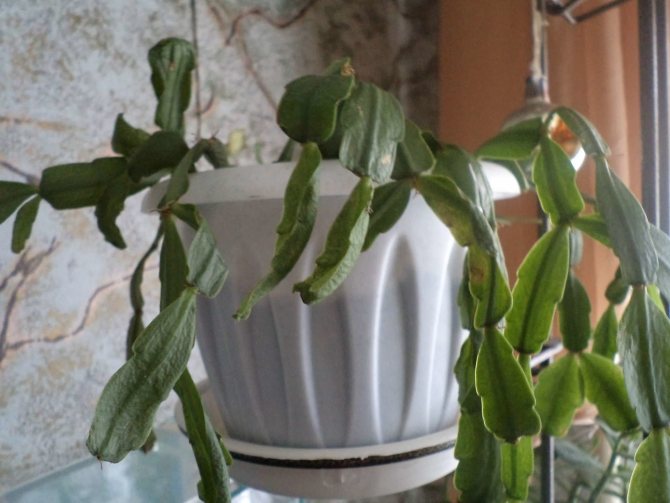

Decembrist in need of treatment.
To exclude the defeat of the Decembrist by various diseases, it is necessary to create unfavorable conditions for them. To do this, it is enough to provide good ventilation of the roots and minimize the intake of moisture.
For the plant to feel normal, it is necessary:
- systematically ventilate the room in which it is located;
- avoid over-watering;
- regularly loosen the soil in the flowerpot.
Why the Decembrist does not bloom at home
If for many years the Decembrist regularly bloomed on time, and then simply stopped, you need to quickly find out what the reason is. If left to chance, culture may stop producing flowers altogether. So, why does the Decembrist flower not bloom at home?
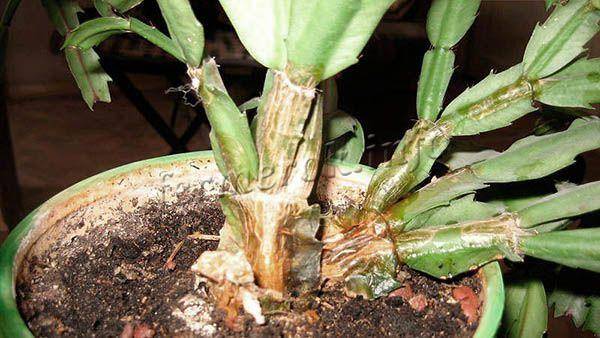

Photo of the root rot of the Decembrist
- Bad pot.
- Lack of nitrogen, potassium or phosphorus.
- Too much or little moisture.
- Failure to observe the period of rest and recovery, as a result of which the plant simply does not have time to rest normally and therefore does not give flowers.
- Excess or lack of lighting.
- Diseases, pests.
- Dry air.
Humidity
For healthy growth and bright flowering for the Decembrist, increased room humidity is needed. Dry air provokes drying of segments and buds, their subsequent falling off. The spider mite also loves low humidity and begins to develop and multiply on the surface of the bush.
Why rhododendron does not bloom outdoors in the garden: what to do
To increase the humidity level, you need to regularly spray the bush with water from a spray bottle. In winter, due to artificial heating, the humidity decreases, so you need to put a container with water next to the pot.
Additional Information. For a quick increase in humidity in winter, it is effective to lay out a damp cloth on the hot heating pipe.
Signs and superstitions associated with the Christmas tree
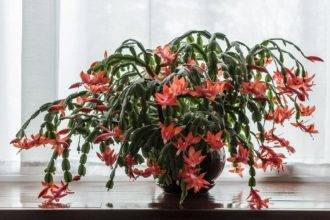

The Decembrist is a "family" flower, and all the signs associated with it concern both the family as a whole and each of its members separately. Thanks to the plant, you can foresee what event, joyful or sad, will happen in the near future.
- If the zygocactus bloomed on time, it means that the family will live in peace and prosperity throughout the coming year.
- In case the flower has blossomed prematurely, you should prepare for a wedding or replenishment in the family.
- A Christmas tree is an indicator of family relations: if it has not bloomed for several years, then, most likely, an unfavorable psychological atmosphere reigns in the family. The plant tells its owners that it is necessary to take certain measures to stabilize the situation in the family.
- This flower is also sensitive to family ill-wishers. If the flower is sick, wasting away before our eyes, then all family members need to analyze whether the “deterioration of health” of the Decembrist is connected with the appearance of a certain guest in the house. It is believed that in this way the plant helps the owners to see the insincere and negative person in their environment.
- Many people are afraid to start a Decembrist in the house due to the fact that he is a "prophet" of death: if the plant is unreasonably ill and died, then soon one should wait for the death of one of the household, the flower will take him with him to the other world.
- Another unpleasant sign: the girl whose room this plant decorates will never marry, and if she does, she will be deeply unhappy in marriage.
Folk omens
Signs and popular superstitions about the Decembrist flower are more benevolent than the reviews of modern magicians.
When asked whether it is possible to keep the Decembrist at home, they answer only positively. Decembrist is a flower, which signs and superstitions do not interfere with being a universal favorite. During its flowering, a holiday is felt in the house, because in the snowy period we are not pleased with the colors of the surrounding nature.
At home, zygocactus, during the flowering period, brings us joy, in the midst of the winter cold, on a short sunny day. Let it bloom and, according to popular beliefs, teach us to find a common language with strangers, easily find compromises and ways out of difficult situations. He takes care of the health of his owners, of the mood that reigns in their common home.
Popular rumor says, not at all what the magicians warn us about.So, not timely flowering predicts not the collapse of illusions, but a series of happy surprises. They can be related to family finances, in the form of bonuses or salary increases. In personal life, they give a reason to change something for the better, to build ideal relationships in a family with their soul mate and children.
Keeping a flowering plant at home, can it really change the course of life? Of course not. But they can bring a good mood, create coziness and warmth, our green friends. They completely depend on us, on our mood and desire to take care of them. What energy you have, good or bad, you can endow the plants with this, and they will react to this with their state.
If you do not water a green friend like the Decembrist, he can shed leaves and buds, and no longer bloom. And there is no need to look for bad omens in this and be afraid of predictions. Give your favorites what they ask for. And then the gratitude of home beauties will be that you will receive a gorgeous live fountain of magnificent exotic flowers for the Holy Feast of Christmas. Therefore, let the Decembrist live in the house, and the signs associated with him remain outside your doorstep, without interfering with living and enjoying new, wonderful events.
Magic and mysticism have long become elements of the life of a modern person, someone believes in horoscopes, and someone in omens. It is a generally accepted fact that there are forces that science is not able to explain and analyze, but they harmoniously flow into the life of everyone. There are plants around which mystical rumors circulate and they are classified as talismans, amulets, or, conversely, unwanted guests at home and in the flower bed.
One of these is the Decembrist, or Schlumberger's cactus; the people associate this flower with various signs and superstitions that help to recognize the atmosphere in the house, benevolent people and even the approach of death. Believe it or not in such signs is an individual matter for everyone, but no one will argue that the Decembrist is a very beautiful plant.
Bad light
Too little light during the day prevents flower buds from forming. The flower needs a bright place, it does not tolerate direct sunlight. Direct exposure to sunlight, especially during the daytime, turns the leaves purple. The Decembrist only needs 2-4 hours a day of intense sunlight, preferably at sunset or sunrise.
The Decembrist is a short-day plant; it takes 12 hours of absolute darkness for flowering in the autumn and winter months (from September to December). It should not be placed in rooms where there is access to artificial light at night (street lamp standing at a short distance from the window).
Reasons for the absence of buds
The lack of a flowering period in the Decembrist clearly speaks of improper care. for the plant or its disease.
Lack of lighting
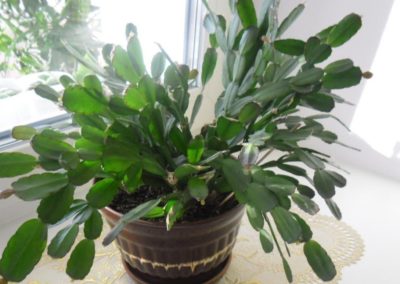

The Decembrist loves diffused lighting and should be in a bright place, where direct sunlight, of which he is afraid, does not penetrate.
Lack of intense light during the day in September-October negatively affects the flowering of Schlumberger, preventing the plant from setting flower buds.
Wherein zygocactus does not need a long day of light, it needs only 2 to 4 hours of intense sunlight, best during sunset or sunrise, which eliminates the need for additional lighting during the cold season.
In the autumn-winter period, the Decembrist needs 12 hours of complete darkness, this gives the plant the opportunity to rest.
Important! There is no need to place the Schlumberger pot in a room where artificial light enters at night.
Unsuitable temperature conditions
One of the common mistakes made by florists, leading to the lack of flowering in the Decembrist, is overheating. - growing a flower when the air temperature is too high, which inhibits its flowering.
Under natural conditions, Schlumberger grows among the branches of trees, where it is quite cool and the temperature during the day is within +21 degrees, which is optimal for the growth and development of the Decembrist. At night, the air temperature should be lower - approximately + 15-18 degrees.
In addition, to lay the buds, the Decembrist needs a period of rest, which will not come if the temperature is too high, which means that the Decembrist will not rest and, as a result, will not bloom.
For Schlumberger bloom, the following temperature conditions must be maintained:
- during the growing process - + 18-20 degrees;
- when laying buds - + 12-14 degrees;
- during the flowering period - + 15-18 degrees.
Lack of a dormant period
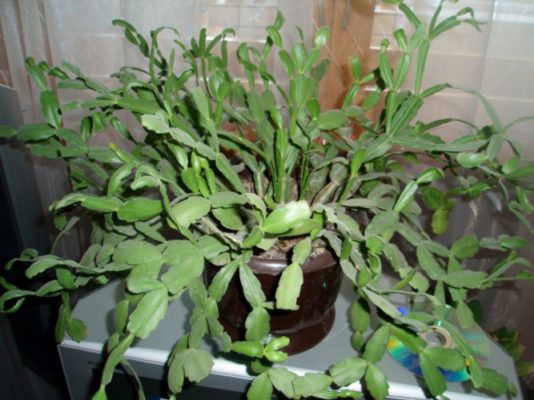

Schlumberger is a plant that blooms in winter, so the time from mid-October to the end of November is especially important for him - this is the time of the Decembrist's rest period.
At this time, the zygocactus should be placed in a dark, cool place, the flower should not be disturbed, even watering must be minimized - water no more than 1 time in 2-3 weeks with a small amount of water. Such a rest is necessary for the Decembrist about 50 days before the expected flowering process.
Pot too big
The opinion that any plant will be comfortable in a large pot is wrong. Not all flowers have a well-developed root system.
A large amount of soil in a flowerpot requires a lot of moisture, which a plant with a not too developed root system does not use. Waterlogged soil leads to the fall of the buds that have appeared and the development of diseaseseg root rot.
Schlumberger's root system is poorly branched, so small containers are more suitable for the flower. In addition, planting a Decembrist in a large flowerpot will lead to the fact that he will spend all his energy on the growth and development of the root system until he has mastered all the soil and flowering will not come.
Reference! The best option for a zygocactus is a low, wide flowerpot.
Moving from place to place
Zygocactus reacts painfully to all movements, change of location and even rotation of the flowerpot. As soon as the Schlumberger began to form flower buds, you should not touch the flowerpot with the plant - this can provoke stress in the Decembrist and he will begin to shed the buds.
Dry air
Humidity plays a key role in the life of exotic plants. Being in a room with a low level of air humidity, Schlumberger is not able to engage in the laying of flower buds. Dry indoor air leads to the fact that the Decembrist, ready to enter the flowering period, begins to shed its buds. In such a situation, the next flowering will not come earlier than in a year.
Diseases and pests
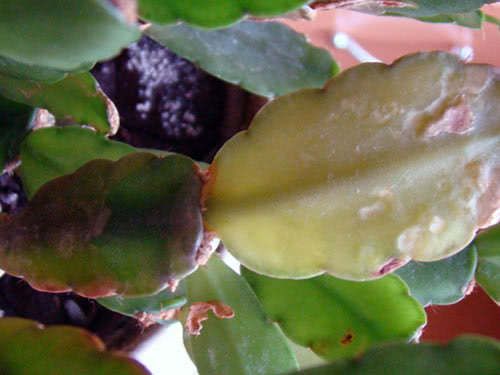

Decembrist is not protected from attacks of harmful insects that feed on plant sap. Because of this, the flower loses its vitality, cannot resist infectious diseases, and loses its ability to bloom.
Most often at home Schlumberger suffers from mealybug, scale insect and spider mite attacks.
Due to the defeat of a spider mite, the zygocactus sheds a significant part of the segments and buds.
Also, the plant is susceptible to the development of fungal diseases such as late blight, fusarium, pytium. Most often, they develop in a weakened flower and further aggravate its condition. If you do not notice the symptoms in time or ignore them and do not take measures to treat zygocactus, it may die.
Attention! Insect pests enter the home through soil that has not been disinfected.
Lack of fertilizers
With time the soil in which the zygocactus grows is depleted, and the flower does not receive the required amount of nutrients, in order to fully grow and develop. Therefore, it is necessary throughout the year, with the exception of the dormant period, to apply mineral fertilizers containing nitrogen, potassium, phosphorus to the ground.
It is necessary to feed the Schlumberger with liquid fertilizers, pouring them into the pot after dilution in accordance with the instructions.
Insufficient watering in summer
In the summer, the Decembrist needs a lot of water... At this time, it is actively growing, and moisture is required for the appearance of new leaves. Also, rare watering leads to deformation of the existing foliage and long-term restoration of the flower after such a drought.
In addition, the abundant summer watering is perceived by the Schlumberger as the rainy season in the tropical forests native to the flower, during which it stores moisture, after which it prepares for flowering. Therefore, it is important to frequently and abundantly water and spray the zygocactus, and it is necessary to reduce watering in the fall, during the dormant period.
Rare transplant
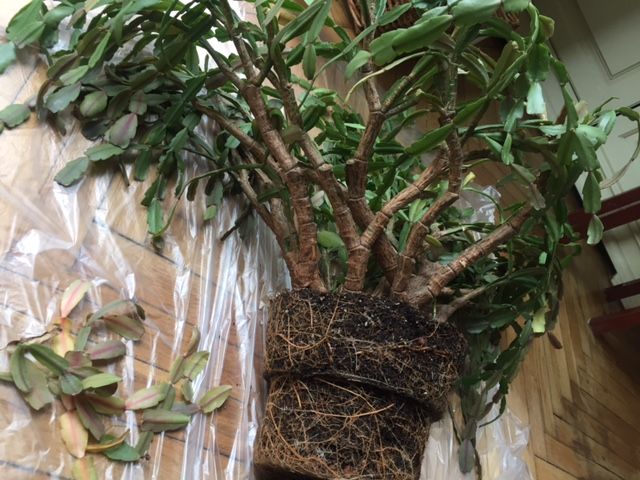

Long-term lack of replanting leads to severe soil depletion, which is unable to fix even top dressing, and its compaction. Because of this, the soil poorly passes the air necessary for the roots. In addition, the likelihood of pests in old soil will increase.
Also, over time, the Schlumberger root system grows and begins to need a larger flowerpot, otherwise the Decembrist withers and stops blooming.

